Evolution of Air Plastron Thickness and Slip Length over Superhydrophobic Surfaces in Taylor Couette Flows
Abstract
1. Introduction
1.1. Unstructured Superhydrophobic Surfaces
1.2. Mechanisms for Slip-On Coated Superhydrophobic Surfaces
1.3. Air Plastron Generation over Coated Superhydrophobic Surfaces
1.4. Objective and Structure of the Paper
2. Experimental Methods and Surfaces Characterization
2.1. Experimental Setup and Surface Fabrication
2.2. Characterization of Surfaces Hydrophobicity
2.3. Experimental Procedure and Measurements Uncertainties
2.4. Characterization of the Flow Regimes of the Taylor–Couette Flows
3. Experimental Results and Statistical Analysis
3.1. Skin Friction Coefficient Measurement
3.2. The Achieved Effective Slip Length
3.3. The Air Plastron Thickness
3.4. Regression Analysis for the Slip Length and the Air Plastron Thickness
4. Conclusions
- Despite minor variations among the tested surfaces, the UED demonstrated the highest static and advanced dynamic contact angles. The used TC cell showed limited turbulence due to its high radius ratio of 0.92, which enabled the flow structure phase diagram to reach the MWVF region at a high rotational speed provided by the rheometer before entering the TTVF region.
- A modified version of the Prandtl–von Kármán skin friction law was developed by applying boundary layer (angular momentum defect) theory to turbulent TC flow. The study allowed for the determination of an effective slip length, “b”, that describes the non-wetting behaviour of superhydrophobic surfaces (SHS) on the outer wall of the TC cell used in WVF and MWVF regions. The results demonstrate that even though super hydrophobic surfaces typically exhibit effective slip lengths of only a few micrometers, they are capable of reducing skin friction in the early turbulent stages (WVT-MWVT) flows.
- A slippage viscous model is used to calculate the plastron thickness at each Reynolds number for all tested SHSs. The comparisons of all the measurement data show a clear relationship between the plastron thickness and the slip length; the UED surface has the highest values of δ+ and b+ among the tested surfaces.
- The attainable drag reduction in TC flows with the three fabricated SHSs is in the range of 7 to 11%.
- The developed regression model shows a direct relation between δ+ and b+ for all tested SHSs. The comparisons between the predicted and measured data showed good agreement. Although there is a small difference in the wetting degree between the tested SHSs, the plastron thickness is directly proportional to the slip length and the water/air dynamic viscosity ratio. The limited number of tested surfaces showed a low impact on the regression model.
Supplementary Materials
Author Contributions
Funding
Data Availability Statement
Acknowledgments
Conflicts of Interest
Nomenclature
| Abbreviation | |
| DR | Drag Reduction |
| SHS | Superhydrophobic Surface |
| SCA | Static Contact Angle |
| CAH | Contact Angle Hysteresis |
| CDC | Concentric Disposal Cups |
| SEM | Scanning Electron Microscope |
| TC | Taylor–Couette |
| Letters | |
| b | Slip Length |
| b+ | Dimensionless Slip Length |
| beff | Effective Slip Length |
| CL | The End Effect Correction Factor |
| Cf | Friction Coefficient |
| d | TC Gap Distance |
| G | Dimensionless Global Torque |
| n | Rotational Speed |
| N | Constant based on Radius Ratio |
| M | Constant based on Radius Ratio |
| MC | Global Torque over Superhydrophobic Surface |
| MWOC | Global Torque over Smooth Surface |
| ri | Inner radius of the TC cell |
| ro | Outer radius of the TC cell |
| Re | Reynolds number |
| Reτ | Shear Reynolds number |
| u | Streamwise velocity |
| uτ | Friction Velocity |
| Ui | Measured Velocity |
| y | Normal flow axis |
| Greek Symbols | |
| α | Torque Exponent |
| Δ | Ratio of Radii |
| δ | Plastron Thickness |
| δ+ | Dimensionless Plastron Thickness |
| Viscous Length | |
| ρ | Density |
| η | Radius Ratio |
| Shear Rate | |
| Γ | Length to Gap Ratio |
| µ | Dynamic Viscosity |
| µa | Air Dynamic Viscosity |
| µw | Water Dynamic Viscosity |
| ν | Kinematic Viscosity |
| τ | Shear Stress |
| τc | Coating surface shear stress |
| τw | Smooth surface (wall) shear stress |
| ω | Angular Speed |
References
- Sullivan, A.; Duan, X. Anti-icing performance of a superhydrophobic and electrothermal coating on metallic substrates. In Proceedings of the 8th Thermal and Fluids Engineering Conference (TFEC-2023), Collage Park, MD, USA, 26–31 March 2023; p. 45657. [Google Scholar]
- Shi, T.; Liang, J.; Li, X.; Zhang, C.; Yang, H. Improving the corrosion resistance of aluminum alloy by creating a superhydrophobic surface structure through a two-step process of etching followed by Polymer modification. Polymers 2022, 14, 4509. [Google Scholar] [CrossRef] [PubMed]
- Nanda, D.; Varshney, P.; Satapathy, M.; Mohapatra, S.S.; Bhushan, B.; Kumar, A. Single step method to fabricate durable superliquiphobic coating on aluminum surface with self-cleaning and anti-fogging properties. J. Colloid Interface Sci. 2017, 507, 397–409. [Google Scholar] [CrossRef] [PubMed]
- Alsharief, A.; Duan, X.; Nyantekyi-Kwakye, B.; Muzychka, Y. Experimental investigation of drag reduction over superhydrophobic surfaces in an open channel flow. In Proceedings of the 8th Thermal and Fluids Engineering Conference (TFEC-2023), Collage Park, MD, USA, 26–31 March 2023; p. 45753. [Google Scholar]
- Lee, C.; Choi, C.H.; Kim, C.J. Superhydrophobic drag reduction in laminar flows: A critical review. Exp. Fluids 2016, 57, 176. [Google Scholar] [CrossRef]
- Cassie, A.; Baxter, S. Wettability of porous surfaces. Faraday Soc. Trans. 1944, 40, 546–550. [Google Scholar] [CrossRef]
- Srinivasan, S.; Choi, W.; Park, K.C.; Chhatre, S.S.; Cohen, R.E.; McKinley, G.H. Drag reduction for viscous laminar flow on spray-coated non-wetting surfaces. Soft Matter. 2013, 9, 5691–5702. [Google Scholar] [CrossRef]
- Rajappan, A.; Golovin, K.; Tobelmann, B.; Pillutla, V.; Choi, W. Influence of textural statistics on drag reduction by scalable, randomly rough superhydrophobic surfaces in turbulent flow. Phys. Fluids 2019, 31, 042107. [Google Scholar] [CrossRef]
- Golovin, K.B.; Gose, J.; Perlin, M.; Ceccio, S.L.; Tuteja, A. Bioinspired surfaces for turbulent drag reduction. Philos. Trans. R. Soc. A Math. Phys. Eng. Sci. 2016, 374, 20160189. [Google Scholar] [CrossRef]
- Park, H.; Choi, C.H.; Kim, C.J. Superhydrophobic drag reduction in turbulent flows: A critical review. Exp. Fluids 2021, 62, 229. [Google Scholar] [CrossRef]
- Fu, Y.F.; Yuan, C.Q.; Bai, X.Q. Marine drag reduction of shark skin inspired riblet surfaces. Biosurface Biotribol. 2017, 3, 11–24. [Google Scholar] [CrossRef]
- Sreenivasan, K.R.; White, C.M. The onset of drag reduction by dilute polymer additives, and the maximum drag reduction asymptote. J. Fluid Mech. 2000, 409, 149–164. [Google Scholar] [CrossRef]
- Samaha, M.A.; Tafreshi, H.V.; Gad-el-Hak, M. Superhydrophobic surfaces: From the lotus leaf to the submarine. Comptes Rendus Mec. 2012, 340, 18–34. [Google Scholar] [CrossRef]
- Piao, L.; Park, H. Two-Dimensional Analysis of Air-Water Interface on Superhydrophobic Grooves under Fluctuating Water Pressure. Langmuir 2015, 31, 8022–8032. [Google Scholar] [CrossRef]
- Ou, J.; Perot, B.; Rothstein, J.P. Laminar drag reduction in microchannels using ultrahydrophobic surfaces. Phys. Fluids 2004, 16, 4635–4643. [Google Scholar] [CrossRef]
- Bullee, P.A.; Verschoof, R.A.; Bakhuis, D.; Huisman, S.G.; Sun, C.; Lammertink, R.G.H.; Lohse, D. Bubbly drag reduction using a hydro-phobic inner cylinder in Taylor-Couette turbulence. J. Fluid Mech. 2019, 883, A61. [Google Scholar] [CrossRef]
- Zhang, P.; Lv, F.Y. A review of the recent advances in superhydrophobic surfaces and the emerging energy-related applica-tions. Energy 2015, 82, 1068–1087. [Google Scholar] [CrossRef]
- Xiang, Y.; Huang, S.; Lv, P.; Xue, Y.; Su, Q.; Duan, H. Ultimate Stable Underwater Superhydrophobic State. Phys. Rev. Lett. 2017, 119, 134501. [Google Scholar] [CrossRef]
- Srinivasan, S.; Kleingartner, J.A.; Gilbert, J.B.; Cohen, R.E.; Milne, A.J.B.; McKinley, G.H. Sustainable drag reduction in turbulent Tay-lor-Couette flows by depositing sprayable superhydrophobic surfaces. Phys. Rev. Lett. 2015, 114, 014501. [Google Scholar] [CrossRef]
- Vajdi Hokmabad, B.; Ghaemi, S. Turbulent flow over wetted and non-wetted superhydrophobic counterparts with random structure. Phys. Fluids 2016, 28, 015112. [Google Scholar] [CrossRef]
- Hokmabad, B.V.; Ghaemi, S. Effect of Flow and Particle-Plastron Collision on the Longevity of Superhydrophobicity. Sci. Rep. 2017, 7, srep41448. [Google Scholar] [CrossRef]
- Seo, J.; Mani, A. Effect of texture randomization on the slip and interfacial robustness in turbulent flows over superhydro-phobic surfaces. Phys. Rev. Fluids 2018, 3, 044601. [Google Scholar] [CrossRef]
- Reholon, D.; Ghaemi, S. Plastron morphology and drag of a superhydrophobic surface in turbulent regime. Phys. Rev. Fluids 2018, 3, 104003. [Google Scholar] [CrossRef]
- Ling, H.; Srinivasan, S.; Golovin, K.; McKinley, G.H.; Tuteja, A.; Katz, J. High-resolution velocity measurement in the inner part of turbulent boundary layers over superhydrophobic surfaces. J. Fluid Mech. 2016, 801, 670–703. [Google Scholar] [CrossRef]
- Gose, J.W.; Golovin, K.; Boban, M.; Mabry, J.M.; Tuteja, A.; Perlin, M.; Ceccio, S.L. Characterization of superhydrophobic surfaces for drag reduction in turbulent flow. J. Fluid Mech. 2018, 845, 560–580. [Google Scholar] [CrossRef]
- Lee, C.; Choi, C.H.; Kim, C.J. Structured surfaces for a giant liquid slip. Phys. Rev. Lett. 2008, 101, 064501. [Google Scholar] [CrossRef]
- Perlin, M.; Ceccio, S. Mitigation of Hydrodynamic Resistance-Methods to Reduce Hydrodynamic Drag; Mitigation of Hydro-dynamic Resistance; World Scientific Co Pte. Ltd.: Hackensack, NJ, USA, 2015. [Google Scholar]
- Reinke, P.; Schmidt, M.; Beckmann, T. The cavitating Taylor-Couette flow. Phys. Fluids 2018, 30, 104101. [Google Scholar] [CrossRef]
- Vinogradova, O.I. Drainage of a thin liquid film confined between hydrophobic surfaces. Langmuir 1995, 11, 2213–2220. [Google Scholar] [CrossRef]
- AP Inc. MCR 302e Manuel and Guideline; Paar, A., Ed.; AP Inc.: Quebec, QC, Canada, 2015. [Google Scholar]
- Lathrop, D.P.; Fineberg, J.; Swinney, H.L. Transion to shear driven turbulence in couette taylor flow. Phys. Rev. A 1992, 46, 6390. [Google Scholar] [CrossRef]
- Maurice Frédéric Alfred Couette. Études sur le Frottement des Liquides; Gauthier-Villars: Paris, France, 1890. [Google Scholar]
- Lathrop, D.P.; Fineberg, J.; Swinney, H.L. Turbulent flow between concentric rotating cylinder at large Reynolds number. Phys. Rev. Lett. 1992, 68, 1515–1519. [Google Scholar] [CrossRef]
- Swinney, H.L. Flow regimes in a circular Couette system with independently rotating cylinders. J. Fluid Mech. 1986, 164, 155–183. [Google Scholar]
- Hall, T.; Joseph, D. Rotating cylinder drag balance with application to riblets. Exp. Fluids 2000, 29, 215–227. [Google Scholar] [CrossRef]
- Lim, T.T.; Tan, K.S. A note on power-law scaling in a Taylor-Couette flow. Phys. Fluids 2004, 16, 140–144. [Google Scholar] [CrossRef]
- Raayai-Ardakani, S.; McKinley, G.H. Geometry mediated friction reduction in Taylor-Couette flow. Phys. Rev. Fluids 2020, 5, 124102. [Google Scholar] [CrossRef]
- Wendt, V.F. Turbulente Stromungen zwischen zwei rotierenden Zylindern. Ingenieur-Archiv 1933, 4, 577–595. [Google Scholar] [CrossRef]
- Tong, P.; Goldburg, W.I.; Huaang, J.S.; Witten, A. Anisotropy in Turbulent Drag Reduction. Phys. Rev. Lett. 1990, 65, 1238. [Google Scholar] [CrossRef]
- Rosenberg, B.J.; Van Buren, T.; Fu, M.K.; Smits, A.J. Turbulent drag reduction over air- and liquid-impregnated surfaces. Phys. Fluids 2016, 28, 015103. [Google Scholar] [CrossRef]
- Greidanus, A.J.; Delfos, R.; Tokgoz, S.; Westerweel, J. Turbulent Taylor–Couette flow over riblets: Drag reduction and the effect of bulk fluid rotation. Exp. Fluids 2015, 56, 107. [Google Scholar] [CrossRef]
- Aydin, E.M.; Leutheusser, H.J. Plane-Couette flow between smooth and rough walls. Expermental Fluids 1991, 312, 302–312. [Google Scholar] [CrossRef]
- Panton, R.L. Panton 1992-Scaling laws for the angular momentum of a completely turbulent couette flow. C. R. Acad. Sci. Ser. II 1992, 315, 1467–1473. [Google Scholar]
- Lewis, G.S.; Swinney, H.L. Velocity structure functions, scaling, and transitions in high-Reynolds-number Couette-Taylor flow. Phys. Rev. E-Stat. Phys. Plasmas Fluids Relat. Interdiscip. Top. 1999, 59, 5457–5467. [Google Scholar] [CrossRef]
- Dong, S. Direct numerical simulation of turbulent Taylor—Couette flow. J. Fluid Mech. 2007, 587, 373–393. [Google Scholar] [CrossRef]
- Seo, J.; Mani, A. On the scaling of the slip velocity in turbulent flows over superhydrophobic surfaces. Phys. Fluids 2016, 28, 025110. [Google Scholar] [CrossRef]
- Fairhall, C.T.; Abderrahaman-Elena, N.; García-Mayoral, R. The effect of slip and surface texture on turbulence over superhy-drophobic surfaces. J. Fluid Mech. 2019, 861, 88–118. [Google Scholar] [CrossRef]
- Choi, C.H.; Ulmanella, U.; Kim, J.; Ho, C.M.; Kim, C.J. Effective slip and friction reduction in nanograted superhydrophobic mi-crochannels. Phys. Fluids 2006, 18, 087105. [Google Scholar] [CrossRef]
- Aziz, H.; Tafreshi, H.V. Role of particles spatial distribution in drag reduction performance of superhydrophobic granular coatings. Int. J. Multiph. Flow 2018, 98, 128–138. [Google Scholar] [CrossRef]
- Zhao, J.; Du, X.; Shim, X. Experimental research on friction-reduction with superhydrophobic surfaces. J. Mar. Sci. Appl. 2007, 6, 58–61. [Google Scholar] [CrossRef]
- Xue, Y.; Lv, P.; Lin, H.; Duan, H. Underwater superhydrophobicity: Stability, design and regulation, and applications. Appl. Mech. Rev. 2016, 68, 030803. [Google Scholar] [CrossRef]
- Vinogradova, O.I. Slippage of water over hydrophobic surfaces. Int. J. Miner. Process. 1999, 56, 31–60. [Google Scholar] [CrossRef]



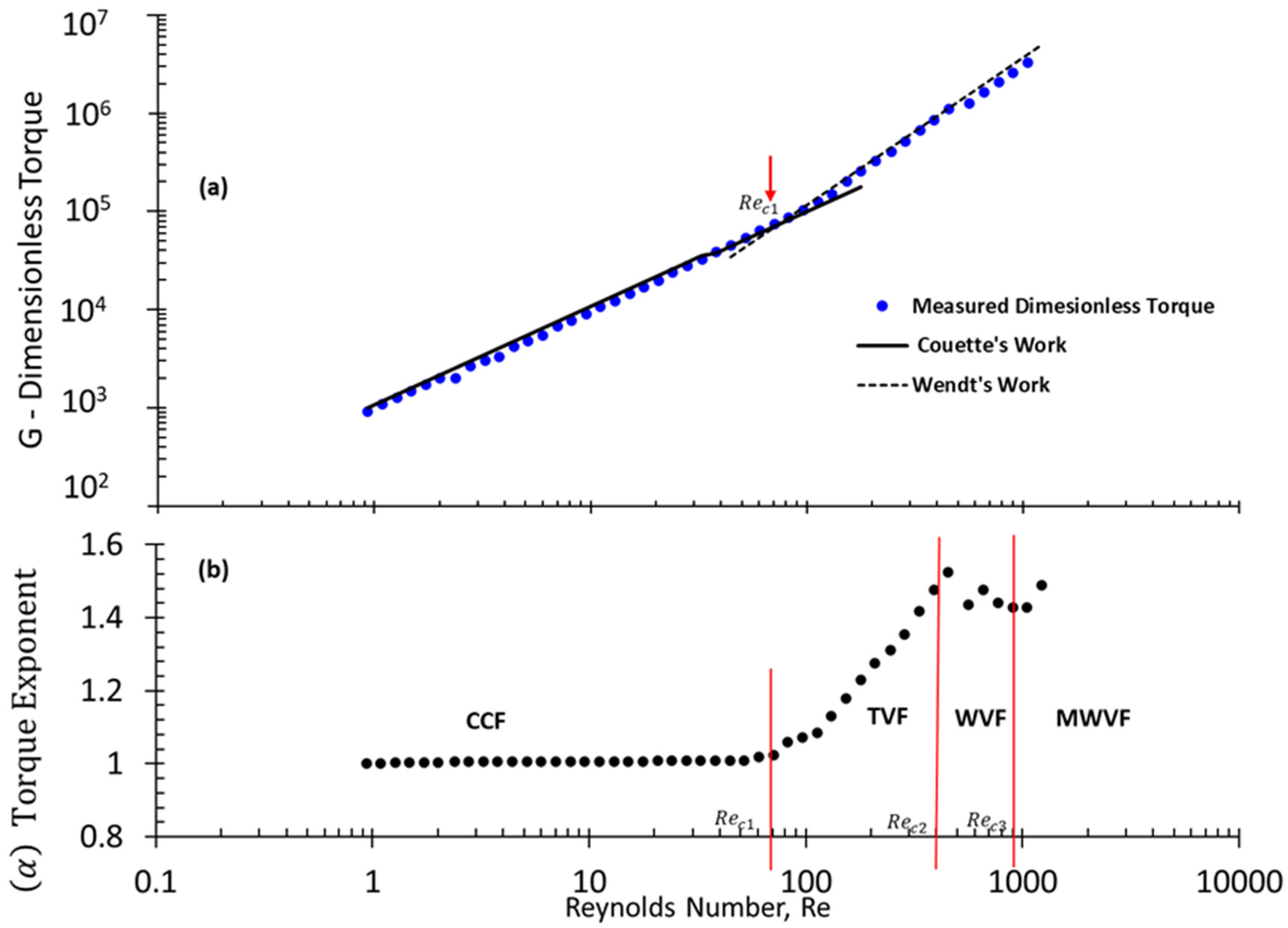
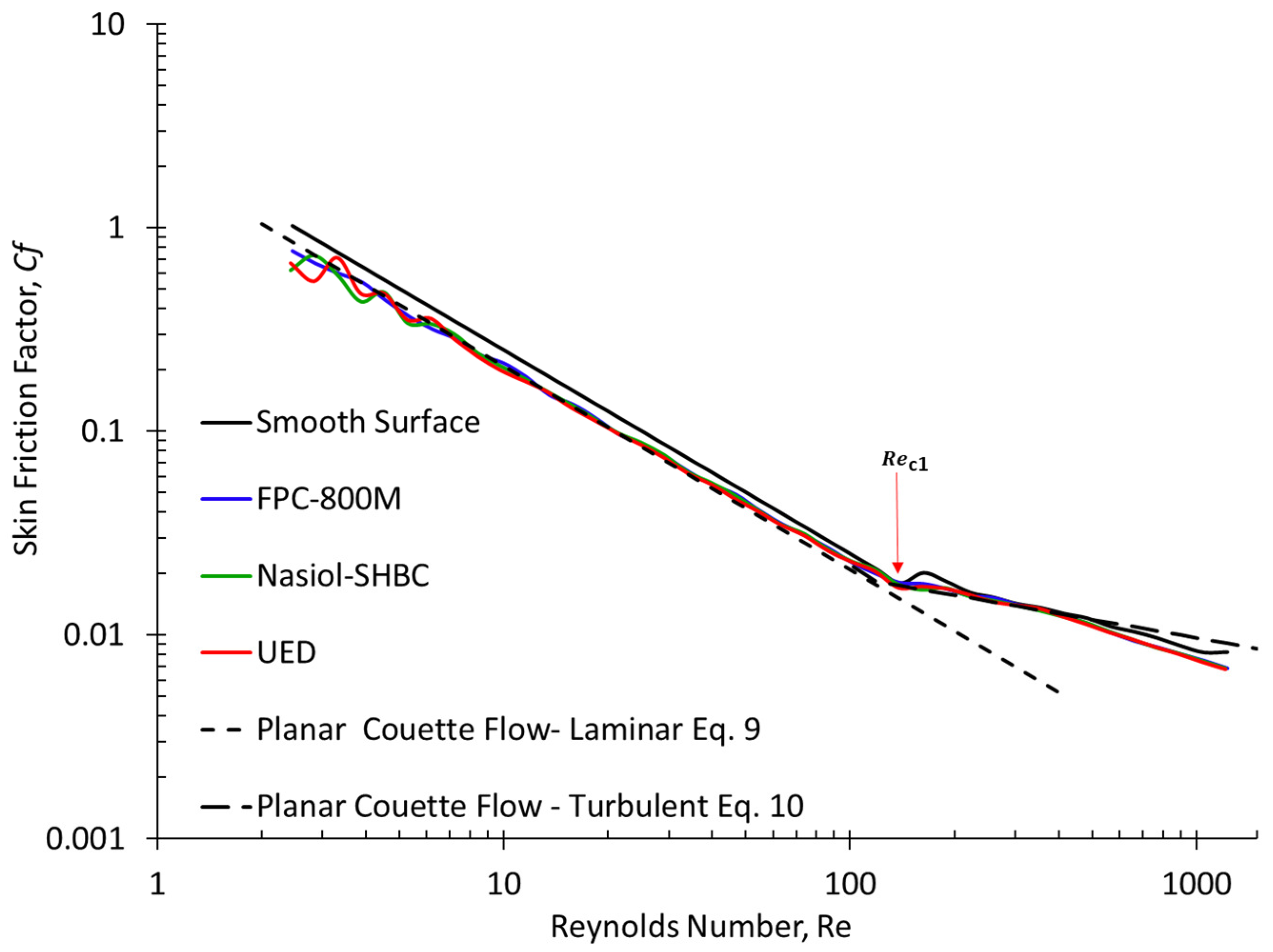
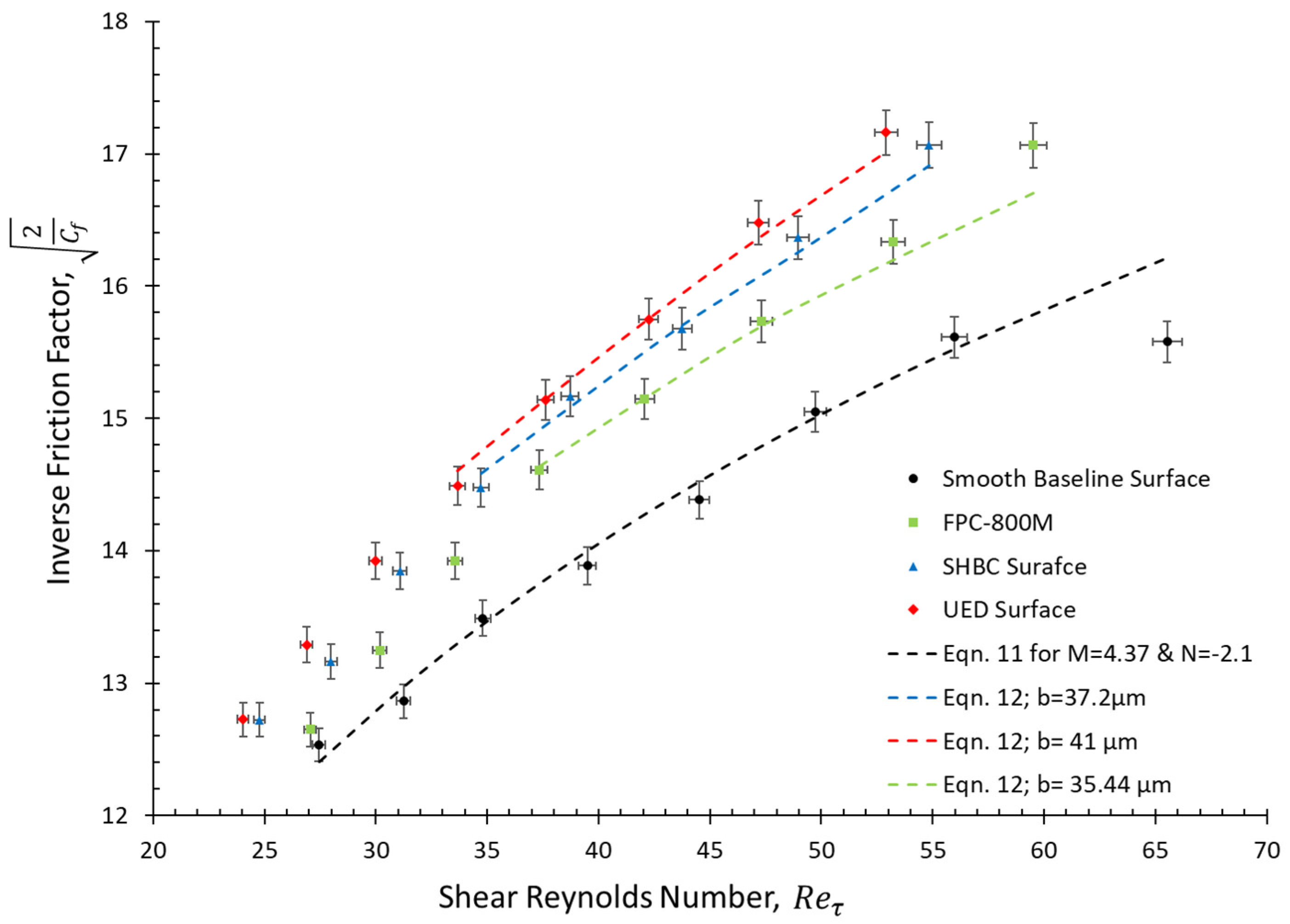

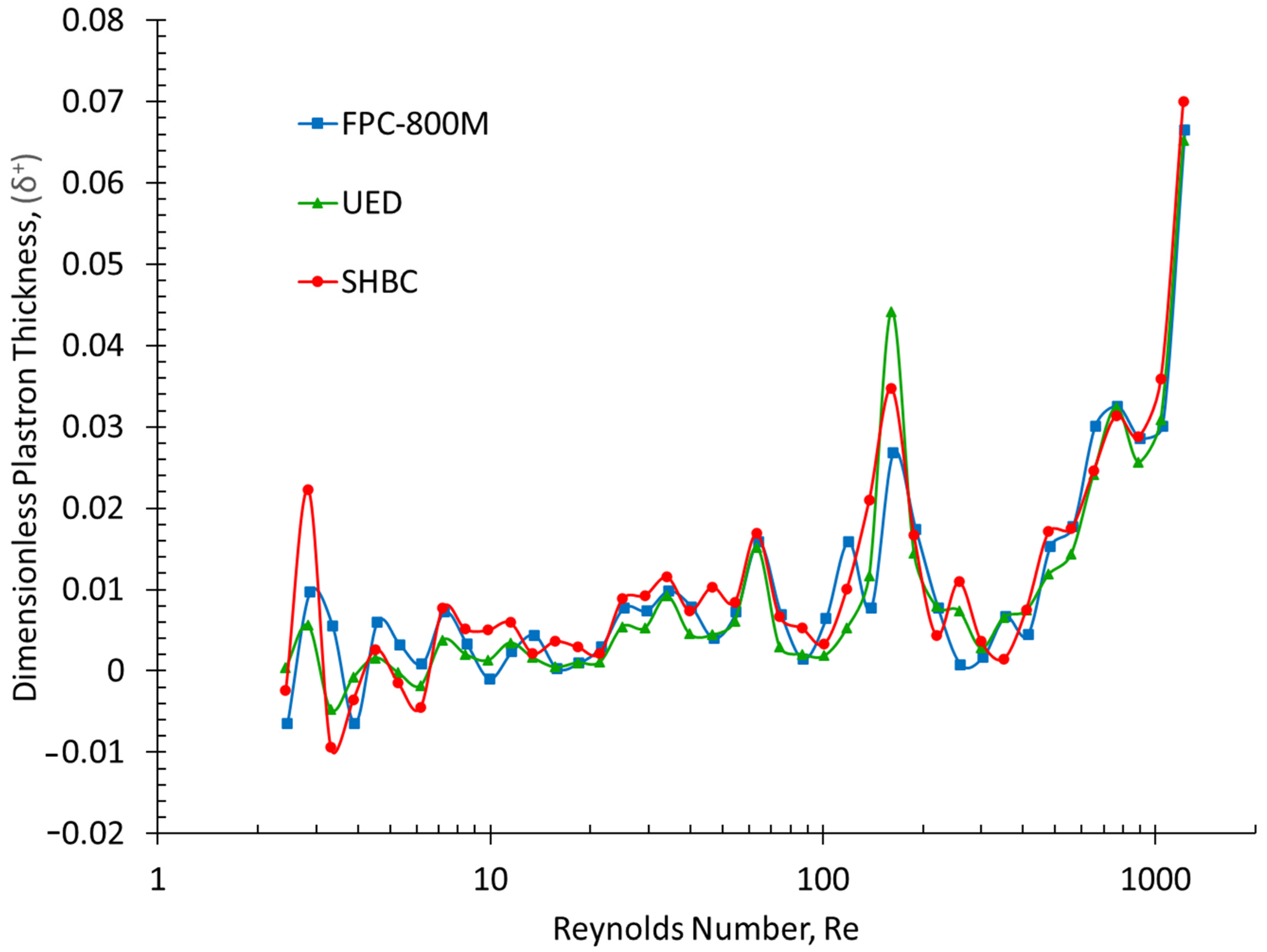
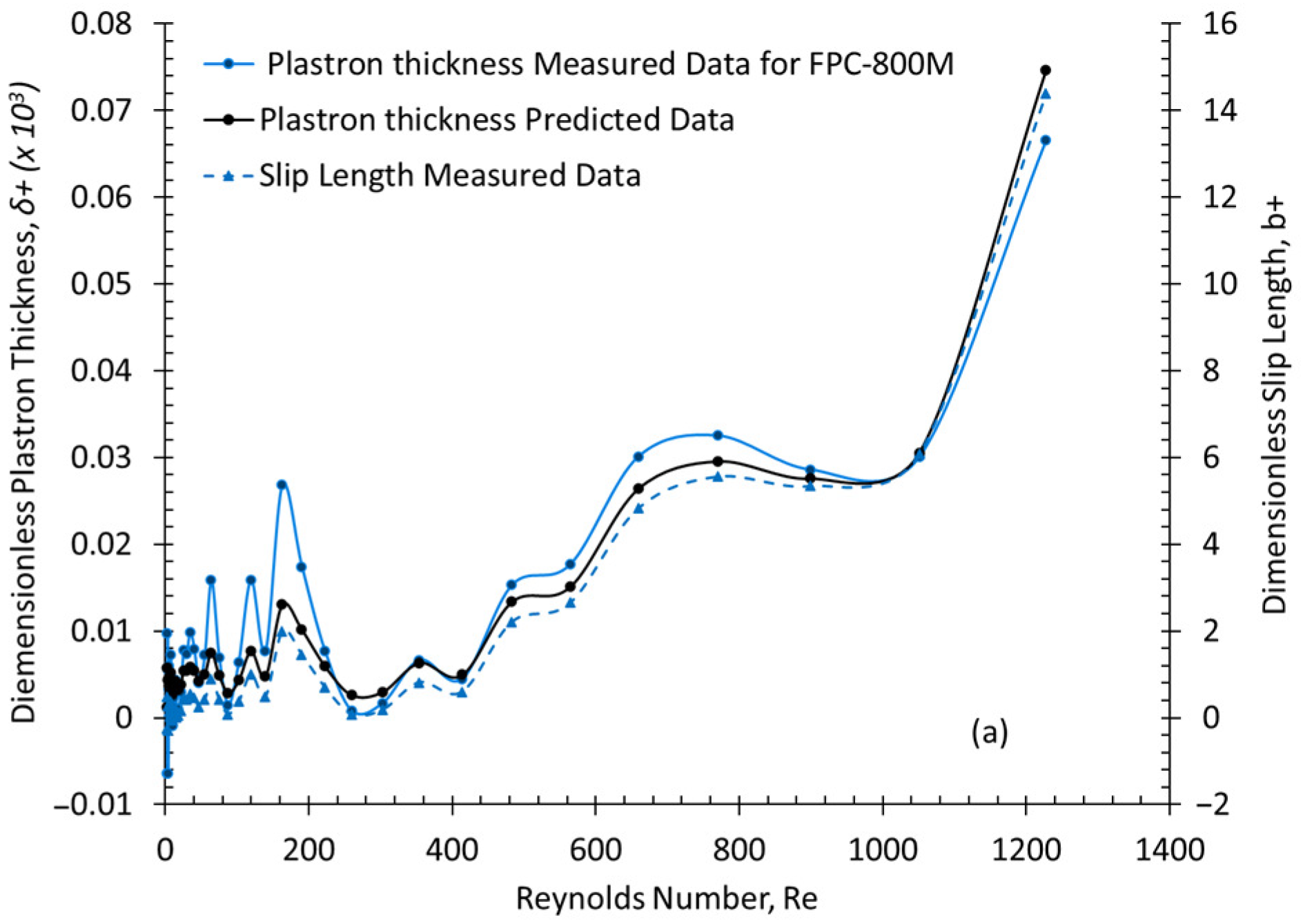
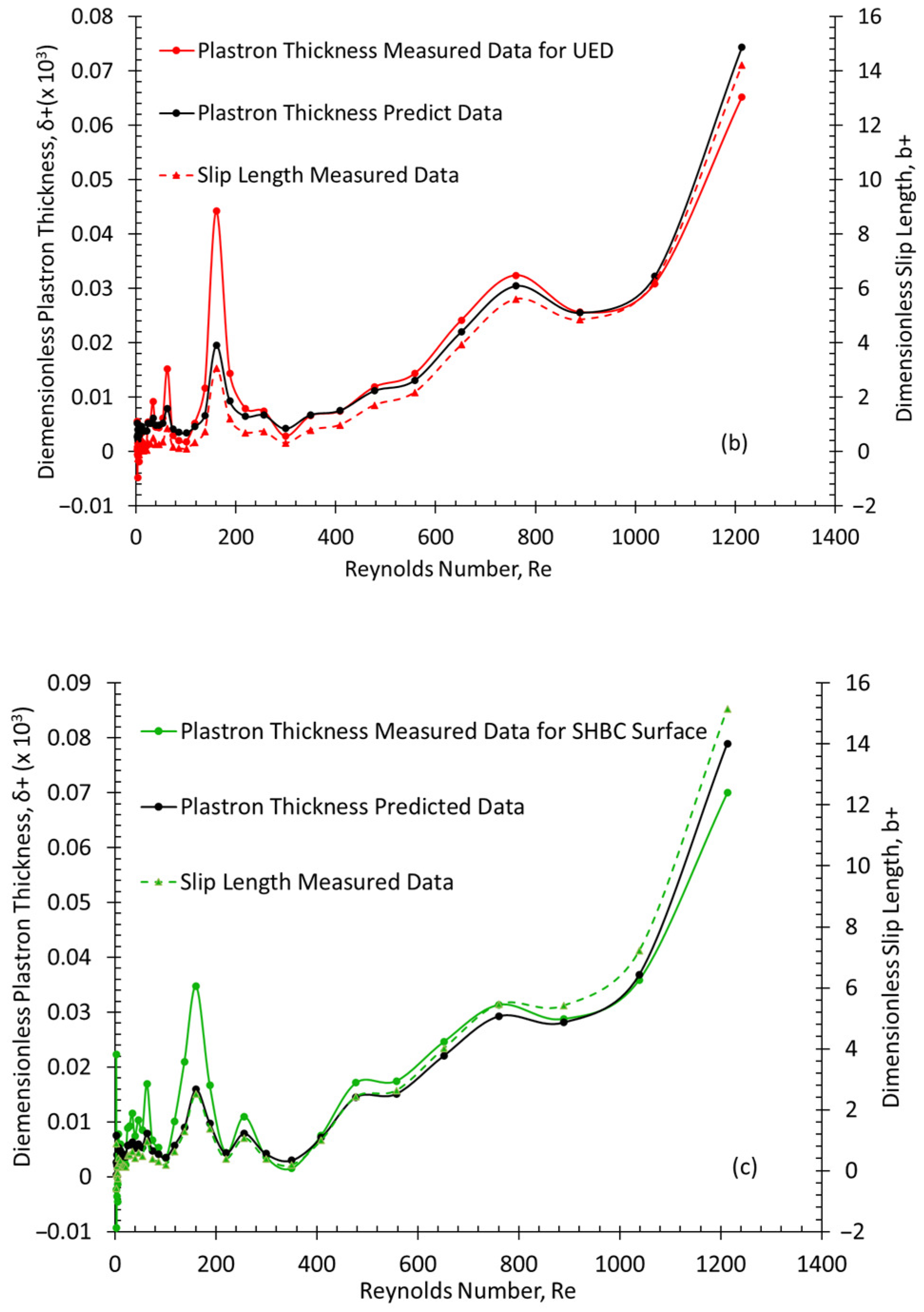
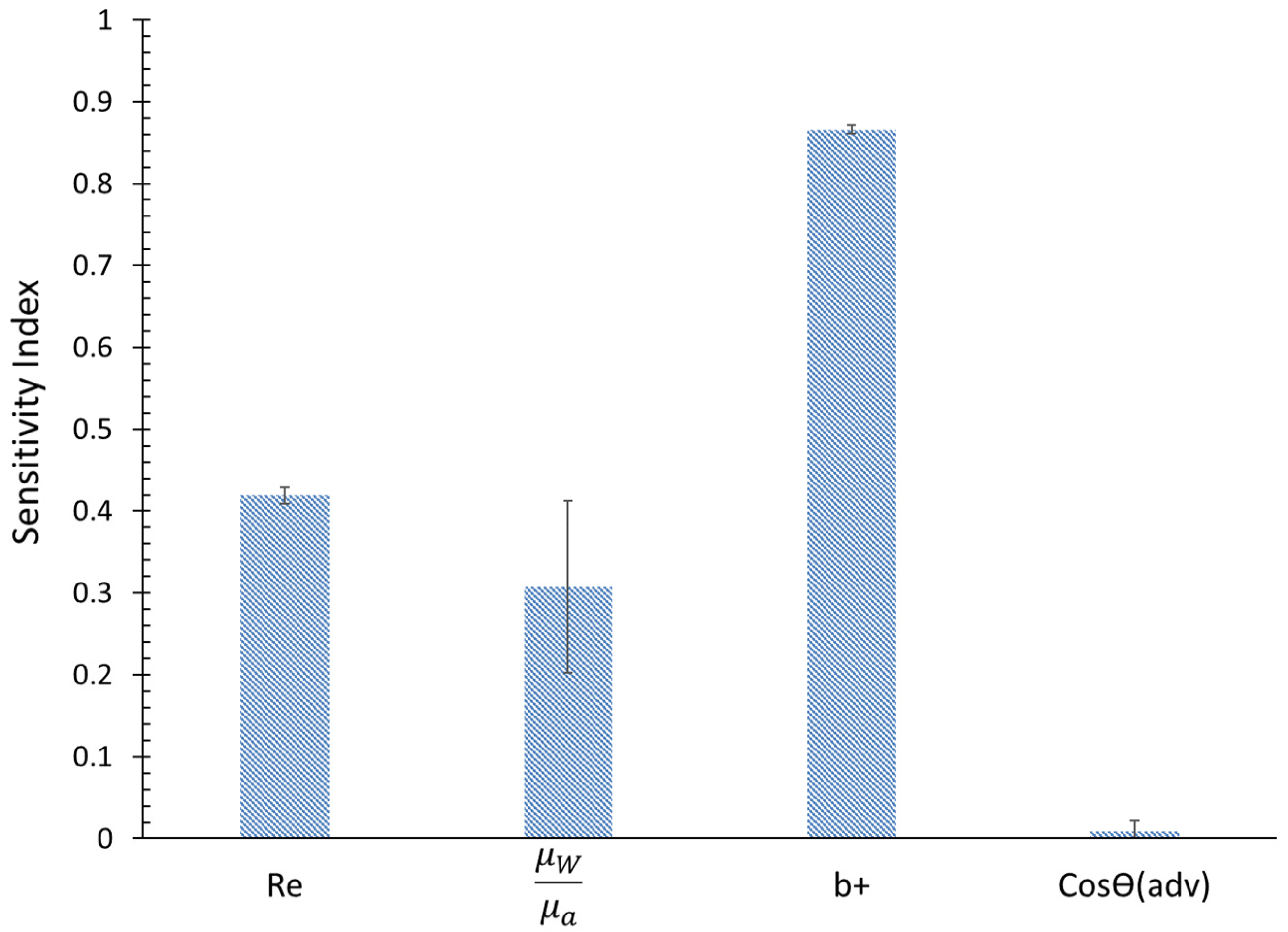
| FPC-800M | UED | SHBC | |
|---|---|---|---|
| Static Contact Angle | 150 ± 5 | 158 ± 5 | 152 ± 5 |
| Advancing Contact Angle | 155 ± 5 | 156 ± 5 | 154 ± 5 |
| Receding Contact Angle | 148 ± 5 | 155 ± 5 | 153 ± 5 |
| Parameter | Mean | STD.DEV. | N |
|---|---|---|---|
| δ+ | 0.008 | 0.013 | 164 |
| Re | 206.47 | 306.46 | 164 |
| Cos Ɵ | 0.54 | 0.69 | 164 |
| µw/µa | 0.86 | 50 | 164 |
| b+ | 1.001 | 2.36 | 164 |
| Model | R | R2 | Adjusted R2 | STD Error | Changes Statistics | ||||
|---|---|---|---|---|---|---|---|---|---|
| R2 Change | F Change | dF1 | dF2 | Sig. F Change | |||||
| 1 | 0.933 a | 0.871 | 0.868 | 0.0045 | 0.871 | 269.39 | 4 | 159 | 0.0005 |
Disclaimer/Publisher’s Note: The statements, opinions and data contained in all publications are solely those of the individual author(s) and contributor(s) and not of MDPI and/or the editor(s). MDPI and/or the editor(s) disclaim responsibility for any injury to people or property resulting from any ideas, methods, instructions or products referred to in the content. |
© 2023 by the authors. Licensee MDPI, Basel, Switzerland. This article is an open access article distributed under the terms and conditions of the Creative Commons Attribution (CC BY) license (https://creativecommons.org/licenses/by/4.0/).
Share and Cite
Alsharief, A.F.A.; Duan, X.; Muzychka, Y.S. Evolution of Air Plastron Thickness and Slip Length over Superhydrophobic Surfaces in Taylor Couette Flows. Fluids 2023, 8, 133. https://doi.org/10.3390/fluids8040133
Alsharief AFA, Duan X, Muzychka YS. Evolution of Air Plastron Thickness and Slip Length over Superhydrophobic Surfaces in Taylor Couette Flows. Fluids. 2023; 8(4):133. https://doi.org/10.3390/fluids8040133
Chicago/Turabian StyleAlsharief, Ahmed Faraj Alarbi, Xili Duan, and Yuri S. Muzychka. 2023. "Evolution of Air Plastron Thickness and Slip Length over Superhydrophobic Surfaces in Taylor Couette Flows" Fluids 8, no. 4: 133. https://doi.org/10.3390/fluids8040133
APA StyleAlsharief, A. F. A., Duan, X., & Muzychka, Y. S. (2023). Evolution of Air Plastron Thickness and Slip Length over Superhydrophobic Surfaces in Taylor Couette Flows. Fluids, 8(4), 133. https://doi.org/10.3390/fluids8040133









